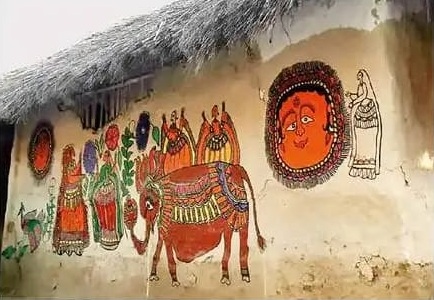Introduction
Kohbar painting is an ancient folk art native to the Indian states of Jharkhand and Bihar, deeply intertwined with marriage rituals and local cultural celebrations. This art form uses entirely natural colors sourced from earth, plants, and minerals, reflecting a unique blend of tradition and artistic expression. Kohbar decoration primarily appears on the walls of rooms where marriage ceremonies take place, symbolizing blessings for the newlywed couple.
Features of Kohbar Painting
Use of Natural Colors
The natural colors are central to Kohbar painting's authenticity:
Red, Yellow, and White hues are extracted from clay and tree barks.
White is derived from a type of clay called dudhi mitti.
Black color is made by grinding seeds from the bhelwa tree.
Natural Brushes and Techniques
The paintings are made using natural brushes and implements such as:
Fingertips,
Wooden combs (now sometimes replaced by plastic combs),
Twigs called datun,
which emphasize the handcrafted and organic nature of the art.
Importance in Marriage Ceremonies
Decoration of the Kohbar Room
During weddings, a specific room (called the Kohbar room) in the bride’s home is decorated with these intricate wall paintings. This room is where the bride resides after marriage, and the artwork is considered auspicious and essential to the ceremony.
Kohbar Worship and Songs
Both the bride's and groom’s families perform rituals called Kohbar Poojan, worshiping the Kohbar paintings. Folk songs called Kohbar Geet are sung to express love and deepen the bond between the bride and groom during these ceremonies.
Cultural and Historical Significance
Geographical Indication (GI) Tag
In 2020, the Jharkhand government obtained the Geographical Indication (GI) tag for Kohbar painting, recognizing its cultural heritage and unique regional identity.
Tribal Contributions
Kohbar painting is predominantly practiced by tribal women belonging to communities such as the Santhal, Munda, Oraon, Kurmi, Ghatwal, Agariya, and others. The skills are traditionally passed down from mother to daughter.
Modern Context and Challenges
Despite its rich cultural heritage, Kohbar painting faces challenges due to changing architecture from mud houses to cement structures and urbanization. Efforts have been made to preserve this art form by adapting it to newer mediums like paper and canvas, which help sustain the artists’ livelihoods and keep the tradition alive.
Key Facts (Exam-Oriented)
Kohbar painting is linked to marriage rituals in Jharkhand and Bihar.
Uses natural minerals and dyes extracted from local resources.
Primarily done by tribal women as part of nuptial customs.
Includes motifs of peacocks, elephants, turtles, flowers, and symbolic geometric designs.
Received GI tag in 2020.
Performed in the Kohbar room where the bride stays after marriage.
Kohbar Poojan and Kohbar Geet are integral to celebration.
Passed on matrilineally, showcased in villages especially in Hazaribagh district.
Why this matters for your exam preparation
For UPSC and competitive exams, Kohbar painting is significant for the Art and Culture section. It exemplifies:
The rich tribal heritage and cultural diversity of India.
The importance of GI tags in preserving traditional knowledge.
Links between cultural practices and regional identities.
Current affairs related to tribal arts and government initiatives for preservation.
Understanding such regional art forms helps aspirants cover culture-related questions effectively in prelims and mains, as well as enriches answers in interview stages.
For detailed insights, read more on tribal arts and GI tag updates on Atharva Examwise.







